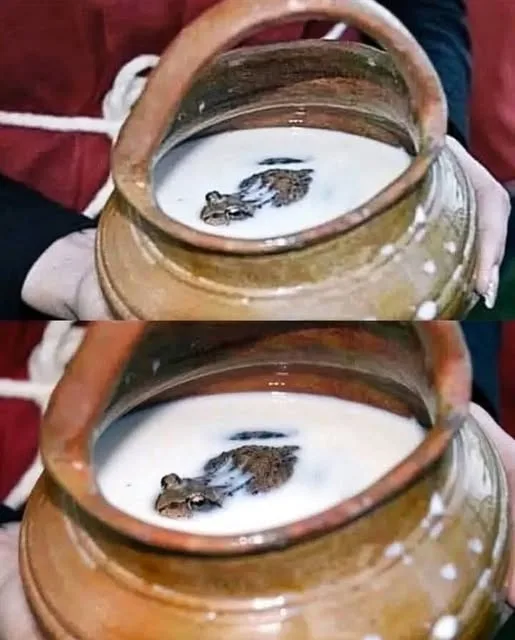Before the hum of refrigerators became a household norm, people around the world devised creative ways to preserve food. In Russia, one particularly peculiar method stood out: placing live brown frogs into buckets of fresh milk. This practice, rooted in folk tradition, might sound like something out of a quirky fairy tale, but it had a practical purpose—keeping milk fresh in the absence of modern cooling technology. Thanks to modern science, particularly the work of Russian scientist Albert Lebedev, we now understand the surprising biochemistry behind this age-old custom.

A Tradition Born of Necessity
In pre-refrigeration Russia, especially in rural areas, keeping milk from spoiling was a constant challenge. Milk is a nutrient-rich environment, making it a breeding ground for bacteria like Staphylococcus aureus and Lactobacillus. Without access to iceboxes or refrigeration, milk could turn sour within hours, especially in warm weather. To combat this, Russian villagers turned to an unlikely ally: the common brown frog, specifically Rana temporaria, a species abundant across Europe and Russia.
The method was simple yet bizarre. Villagers would place a live frog into a bucket of fresh milk, cover it, and leave it for a time. The frog, unharmed, would swim or sit in the milk, and remarkably, the milk would stay fresh for longer than expected. This practice was passed down through generations, likely dismissed by some as superstition. But as science later revealed, there was a biological basis for its effectiveness.
The Science Behind the Slime
In the 21st century, Russian scientist Albert Lebedev and his team at Moscow State University began investigating this unusual tradition. Their research uncovered that the skin of brown frogs secretes a cocktail of antimicrobial peptides—small proteins that act as natural antibiotics. These compounds, including temporins and brevinins, are part of the frog’s defense mechanism against pathogens in their damp, microbe-rich environments.
When a frog was placed in milk, these peptides were released into the liquid, creating an inhospitable environment for bacteria. The peptides disrupt bacterial cell membranes, effectively slowing or preventing the growth of spoilage-causing microbes. Lebedev’s studies confirmed that these secretions could inhibit common milk-spoiling bacteria, such as Staphylococcus aureus and Escherichia coli, thereby extending the milk’s shelf life.
For example, temporins, a class of peptides found in Rana temporaria, are particularly effective against Gram-positive bacteria. These peptides are short, amphipathic (having both water-attracting and water-repelling properties), and can penetrate bacterial membranes, causing them to rupture. This natural antimicrobial action was likely the secret behind the milk’s prolonged freshness, turning a folk remedy into a scientifically validated practice.
A Blend of Wisdom and Biochemistry
The use of frogs in milk highlights the ingenuity of pre-modern societies. Without understanding the chemistry involved, Russian villagers tapped into the natural properties of amphibians to solve a practical problem. This practice wasn’t unique to Russia—similar methods have been documented in other cultures, where natural antimicrobial agents, like certain plants or animal byproducts, were used to preserve food.
What makes the frog-in-milk method particularly fascinating is its intersection of biology and culture. Frogs, often abundant in rural areas, were a readily available resource. Their skin, constantly secreting protective compounds to thrive in moist environments, inadvertently became a tool for food preservation. The fact that this method worked consistently enough to become a widespread tradition speaks to the observational skills of those who first adopted it.
Modern Implications and Reflections
Lebedev’s research not only validated this historical practice but also opened doors to modern applications. Antimicrobial peptides from frogs are now studied for their potential in medical and industrial settings. These compounds could inspire new antibiotics or natural preservatives, especially as antibiotic resistance becomes a global concern. The milk preservation technique is a reminder that traditional knowledge can offer valuable insights for modern science.
However, the practice also raises questions about safety and ethics by today’s standards. While the frogs’ secretions helped preserve milk, prolonged exposure to live animals in food could introduce other risks, such as contamination from pathogens not affected by the peptides. Modern hygiene standards would likely discourage such methods, favoring controlled preservation techniques like pasteurization or refrigeration.
Conclusion
The story of frogs in Russian milk buckets is more than a historical curiosity—it’s a testament to human resourcefulness and the hidden wisdom of nature. Long before scientists like Albert Lebedev uncovered the antimicrobial properties of frog skin, villagers were using these creatures to keep their milk fresh. This blend of tradition and science reminds us that even the strangest customs can have a rational basis, waiting to be uncovered by curious minds. So, the next time you pour a glass of milk, spared from spoilage by your refrigerator, spare a thought for the humble brown frog and the role it once played in keeping dairy fresh.





